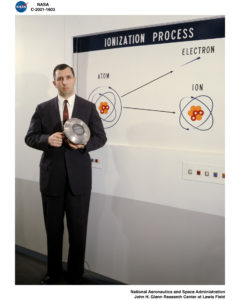Colorado State University Professor Emeritus and former chair of the Department of Physics, Harold R. Kaufman, recently was inducted into NASA’s Glenn Research Center Hall of Fame.

With an exemplary career in the research and development of physics and engineering, Kaufman was welcomed into the second-ever Hall of Fame ceremony at the Glenn Research Center on Sept. 14, 2016. He was recognized for his trailblazing ion propulsion apparatus, which is still used in space exploration today.
“Kaufman’s work has truly had an impact on long-range spaceflight in an important way,” said College of Natural Science’s Department of Physics chair and professor, Jacob Roberts.
Taking Flight
Kaufman started out as an electronics technician in the Navy during World War II. After the war concluded, Kaufman began taking classes at Northwestern University to become a mechanical engineer. During this time, he became a member of the National Advisory Committee for Aeronautics, which later became NASA.
Accelerating into 1964, Kaufman was announced as the head of the Ion Physics Branch. During his time working for NASA, Kaufman developed his most prized invention, the Kaufman thruster, an electron bombardment ion thruster. It allowed liquid mercury to be ionized by generating a high-efficiency plasma, resulting in low-thrust spacecraft propulsion powered by electricity.
He received various awards during his time with NASA including the James H. Wyld Propulsion Award, IR 100 Award (now the R&D 100 Award), and NASA’s Exceptional Service Award. He later went on to receive his Ph.D. from CSU in 1971.
After 23 years at NASA, Kaufman retired and joined the faculty at the Department of Physics and the Department of Mechanical Engineering at CSU.
Interstellar Headway
From 1978 to 1984, Kaufman mainly focused on plasma science and the development of industrial ion sources at CSU. Kaufman sped up the growth in research activity in each department. This led to his second major accomplishment, now known as the Kaufman ion source, which has applications for semiconductor processing. Here he was also able to further his development of the Kaufman thruster.
“It is particularly exciting to me to trace the arc of Kaufman’s work with the Kaufman thruster from the drawing board all the way through operating spaceflight systems,” Roberts said.
In addition to working in the mechanical engineering and physics departments, Kaufman also started a private company with fellow CSU physics faculty member Steve Robinson. Their research and development company, Kaufman & Robinson, focuses on ion, plasma, and electron source products.
Robinson said, “Harold was strongly drawn to physics and became a rare bird indeed, the only engineer to ever chair the physics department. Harold could ‘feel’ how the plasma would respond to a particular configuration, and we would find the mathematical justification for his intuition somewhat later in the process.”
Robinson also commented, “At NASA and here at CSU, Harold trained a generation of scientists and engineers who have dominated ion beam processing and electric space propulsion for decades.”
With over 150 scientific publications and 40 patents, Kaufman is a distinguished researcher and emeritus professor in electric space propulsion and industrial ion sources, which earned him the spot in NASA’s Glenn Research Center Hall of Fame.
Robinson said, “I think history might show that Harold’s work was the most influential of anything done at NASA Glenn; so, he richly deserves to be recognized there.”